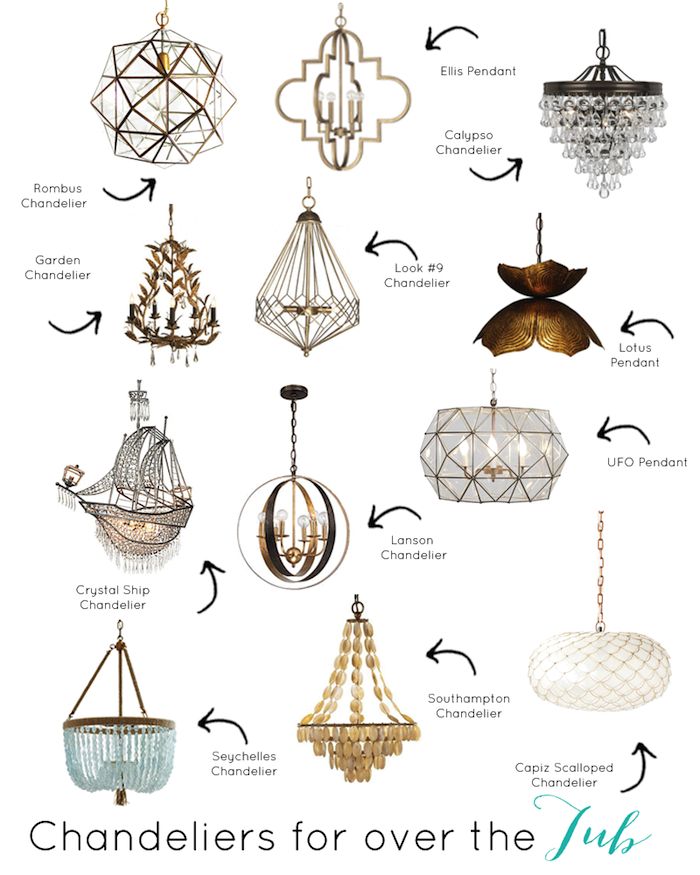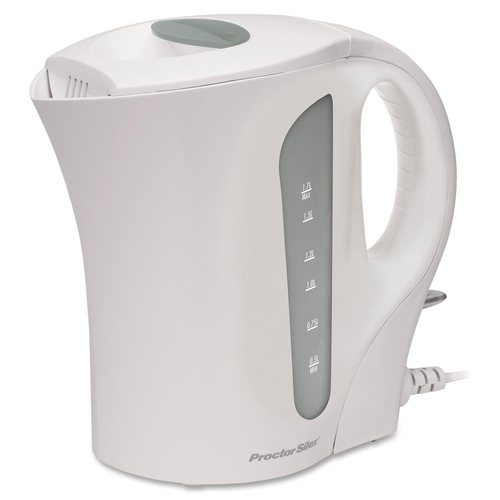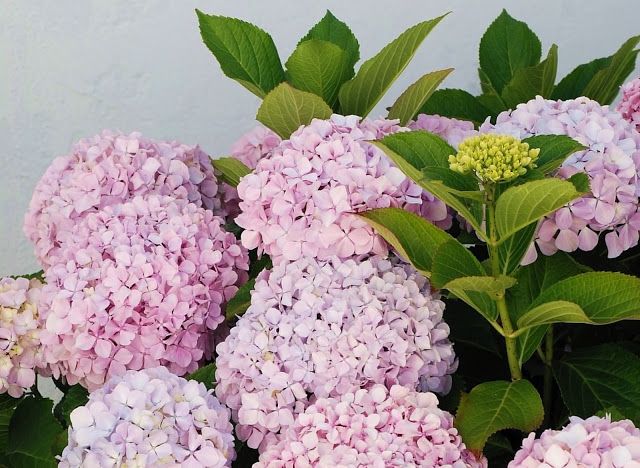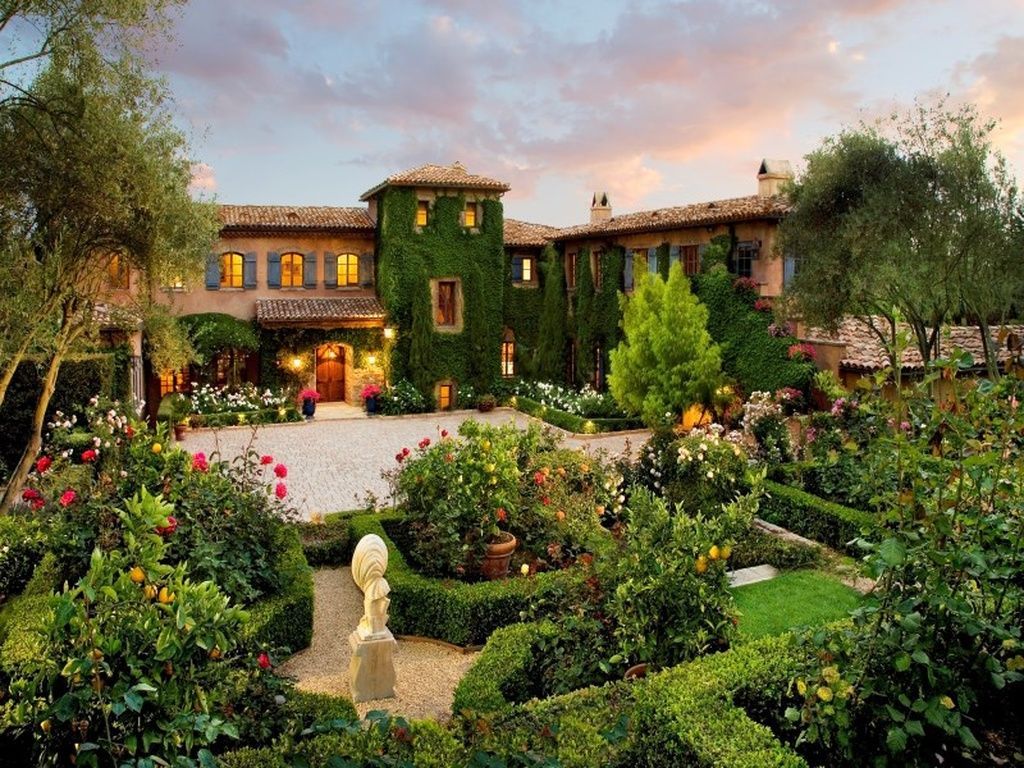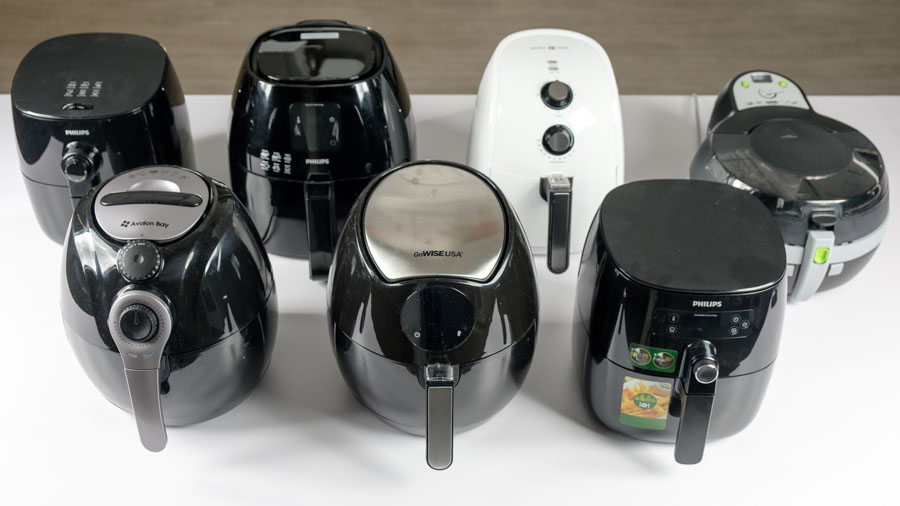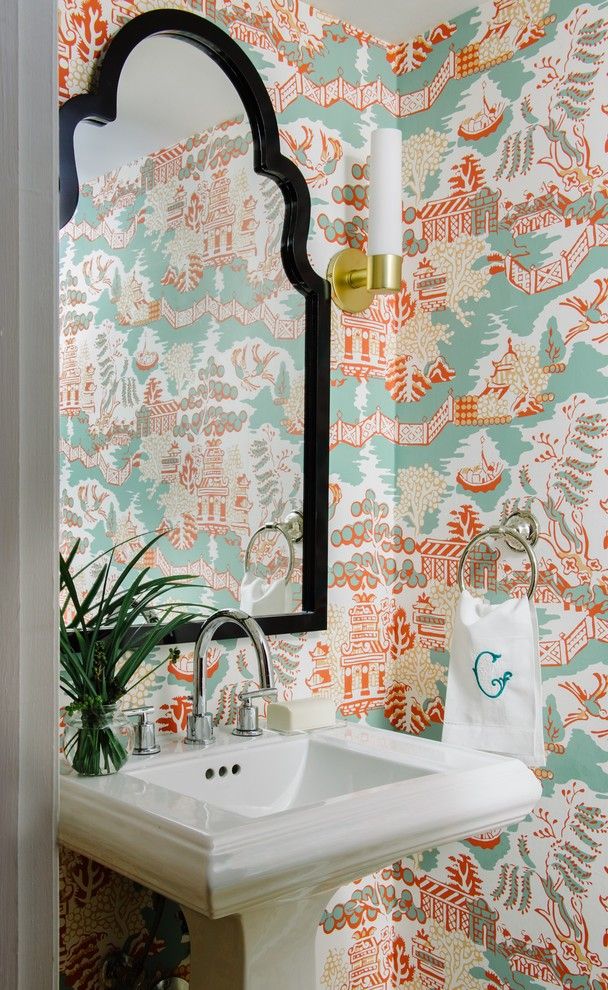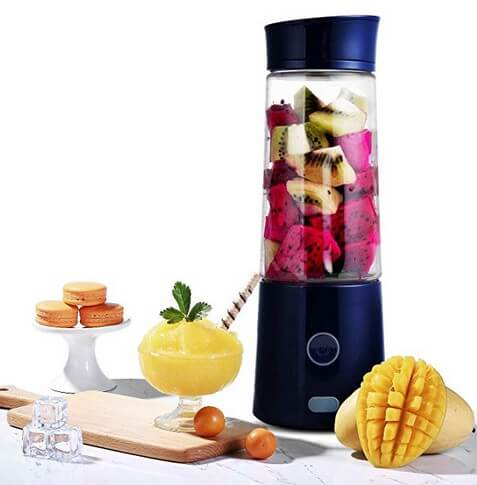Chandelier for over bathtub
Chandelier Over Tub Design Ideas
view full size
Bathroom features a beige beaded sphere chandelier over a freestanding oval bathtub with a brass deck mount tub filler.
Pure Salt Interiors
view full size
Elegant bathroom features a capiz chandelier that illuminates a freestanding bathtub with aged brass gooseneck tub filler and a hand accent table.
Jennifer Backstein Interiors
view full size
A bling chandelier illuminates an oval bathtub with a brass vintage hand held tub filler atop a light gray marble floor.
Lux Decor
view full size
Spacious bathroom features a rope drum chandelier over a white oval free standing bathtub with nickel faucet under a window.
Graystone Custom Builders
view full size
A cream tassel chandelier illuminates an over extra long oval bathtub with a nickel floor mount tub filler.
Ashley Montgomery Design
view full size
Contemporary bathroom features a black agate chandelier over a marble clad bathtub accented with a brass mount tub filler.
Geoff Chick
view full size
Master bathroom features a freestanding bathtub with nickel tub filler in front of a marble window seat flanked by French washstands topped with marble, lit by an Amber French chandelier hung from a tray ceiling and a gold accent table.
Marie Flanigan Interiors
view full size
Contemporary bathroom features a white beaded chandelier over a rectangular pedestal tub with a brass gooseneck floor mount tub filler on white and gold chevron floor tiles.
Mrs Paranjape Design
view full size
Spacious white and gold master bath features a bling chandelier that illuminates an oval bathtub with a brass vintage hand held tub filler under a window, a light gray marble floor, white built in shelves and white cabinets with brass pulls.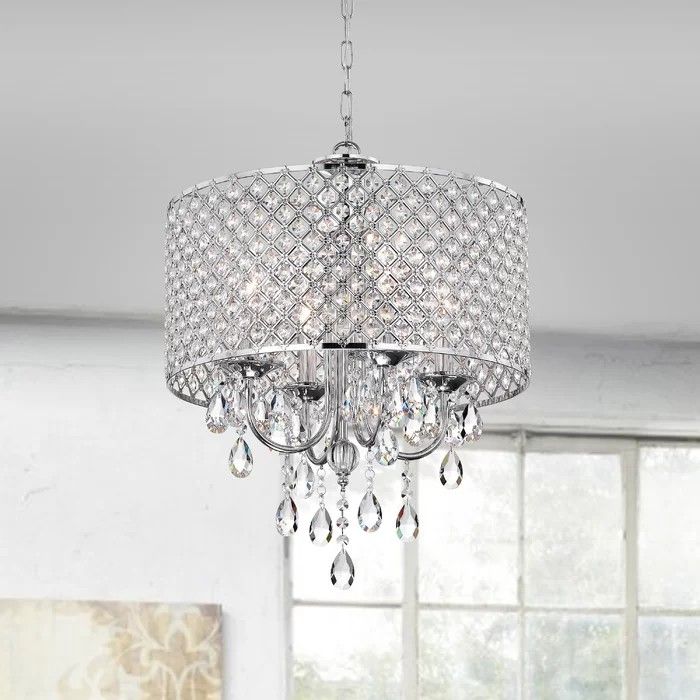
Lux Decor
view full size
Bedroom features a basket chandelier over an oval bathtub under window with a beige grosgrain roman shade and a beige marble pedestal accent table on a vintage rug.
Pure Salt Interiors
view full size
A mini Paris flea market chandelier is hung over a white rectangular bathtub accented with a nickel floor mount bath faucet.
Kim Scodro Interiors
view full size
A basket chandelier illuminates an oval bathtub with an aged brass vintage style hand held tub filler.
Pure Salt Interiors
view full size
Bedroom features a beige marble pedestal accent table with vintage rug next to oval bathtub lit by a basket chandelier.
Pure Salt Interiors
view full size
Bathroom features a beige beaded chandelier over a white oval bathtub with a brass deck mount tub filler in a nook under a window and a round wooden accent table.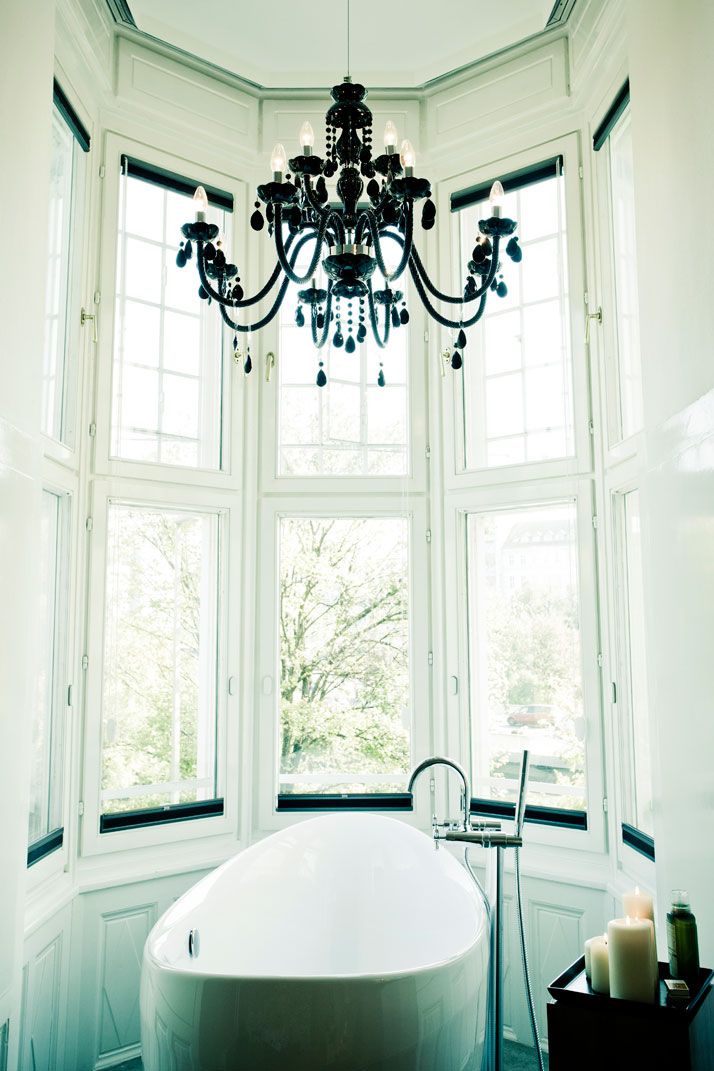
Pure Salt Interiors
view full size
A white beaded chandelier illuminates a freestanding bathtub with an oil rubbed bronze floor mount tub filler and marble grid floor tiles.
Lynde Galloway
view full size
A clear beaded chandelier sits over an oval bathtub with nickel faucet and a light gray marble walk in shower.
Andrea Schumacher Interiors
view full size
An extra large glass bubbles chandelier illuminates a white oval bathtub sitting under a picture window with white and gray geometric wall tiles and a white accent table next to the tub.
HW Interiors
view full size
Bathroom features an oval bathtub lit by a cream capiz shells chandelier and a black tripod accent table.
Laura U Interior Design
view full size
A white and gold cascading chandelier illuminates a white oval bathtub with a brass faucet over white hexagon bath floor tiles.
JLV Creative
view full size
Luxurious bathroom features an arched nook accented with a black and white vintage tub placed on gray and gold marble floor tiles beneath a crystal cascading chandelier, while windows are covered in beige pleated curtains.
Brandon Architects
view full size
Welcoming bathroom features a rustic wooden bath stool placed in a bathtub ook beside an oval bathtub matched with a brass floor mount tub filler.
Amanda Teal Design
view full size
Master bath features a tray ceilng with an amber glass chandelier that illuminates an empire freestanding bathtub with nickel tub filler and gold accent table and a walk in shower with a Calcutta gold marble built in bench under a Calcutta gold marble shower niche and Calcutta gold marble shower floor tiles.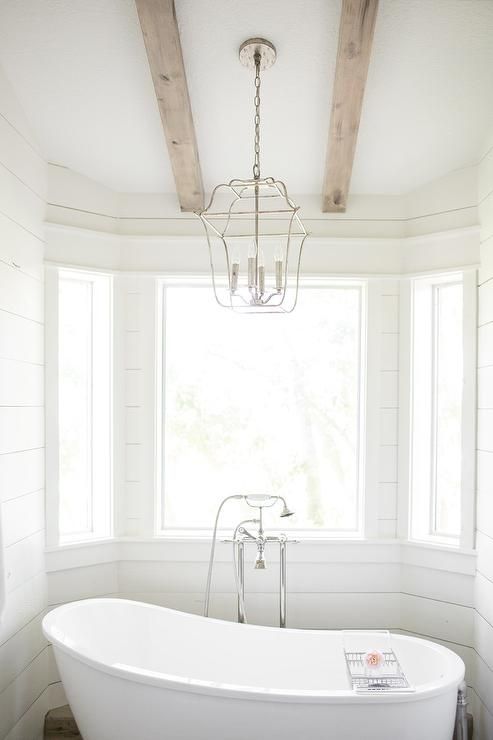
Marie Flanigan Interiors
The Most Ignored Building Code In America - Chandeliers Over Bathtubs
*This post contains affiliate links.
In my last post, I shared that before my computer crashed last week, I had found a beautiful chandelier that I wanted to use for our master bathroom, and I wanted to put it above the bathtub. It looked almost identical to this chandelier, but the price was about half of this one.
Bubble Glass Sputnik Chandelier from Heparts HomeSo yesterday, I went on the hunt for the cheaper version of that chandelier that I had previously found, and in the process, I found this one I like so much better.
Bubble chandelier from ChandelieriaI love that light so much!! I would have already snatched it up except for one thing.
During my whole search for the illusive cheaper version of that first chandelier, I started thinking whether or not I should even be putting a chandelier above the bathtub. After all, most chandeliers above bathtubs are a violation of national building code in the United States.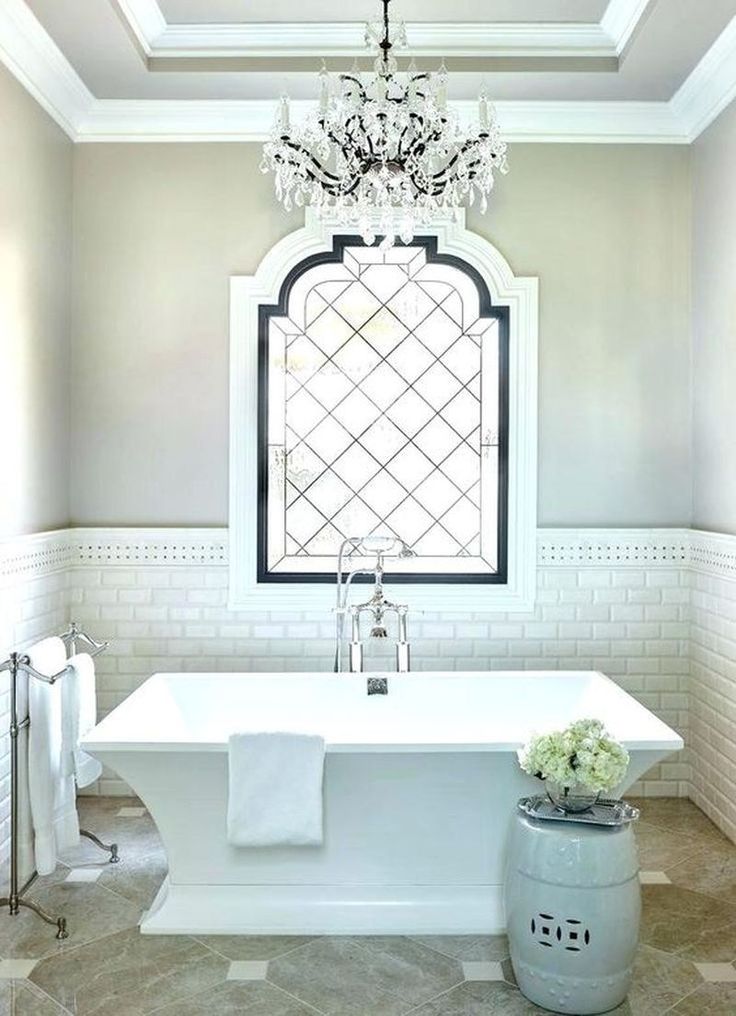
Are you aware of this? I was. I’ve been aware of it for years, and yet, I’ve put chandeliers above bathtubs at least three times in the past. And obviously, it’s not just me. If you go to Pinterest or Houzz or Instagram, you’ll find literally hundreds and hundreds of examples of chandeliers being installed above bathtubs.
It took me about five minutes this morning to collect 74 images of chandeliers above bathtubs on Pinterest. Here’s a sample of them…
Go to Pinterest and put “chandelier over bathtub” in the search and check it out yourself. And these pictures are coming from builders, designers, decorators, bloggers. I saw pictures from very well-known magazines, and even a couple that were from a Parade of Homes, which means that the builders signed off on this and knew that hundreds of visitors to the Parade of Homes would see it and some would be inspired by the idea.
(Note: If you’re reading this post on any website other than Addicted 2 Decorating, that means you’re reading on a site that is stealing my blog content. I hope you’ll consider joining me on my actual blog by clicking here.)
I hope you’ll consider joining me on my actual blog by clicking here.)
You can go to Houzz and search the same thing with the same results. It took me about three minutes to find over 30 examples of chandeliers over bathtubs on Houzz.
I know some of you may be thinking that some of those chandeliers are hung high enough that a person standing in the tub can’t reach them. And that’s true. I’m only five feet tall, and without shoes and standing flat on my feet, my reach is 76 inches. I’d probably be able to touch very few of those chandeliers when standing in those tubs (although there are a few that are ridiculously low, and I could definitely touch them).
But the building code might shock you. It says that the lowest point of the chandelier (including any non-electrical parts like crystals or baubles of any kind that are attached to the light fixture) must be eight feet above the highest point on the walls of the bathtub.
So that means that with the bathtub I’m using, which stands at just under 24 inches high, the lowest part of a chandelier above the tub would have to be 10 feet from the floor.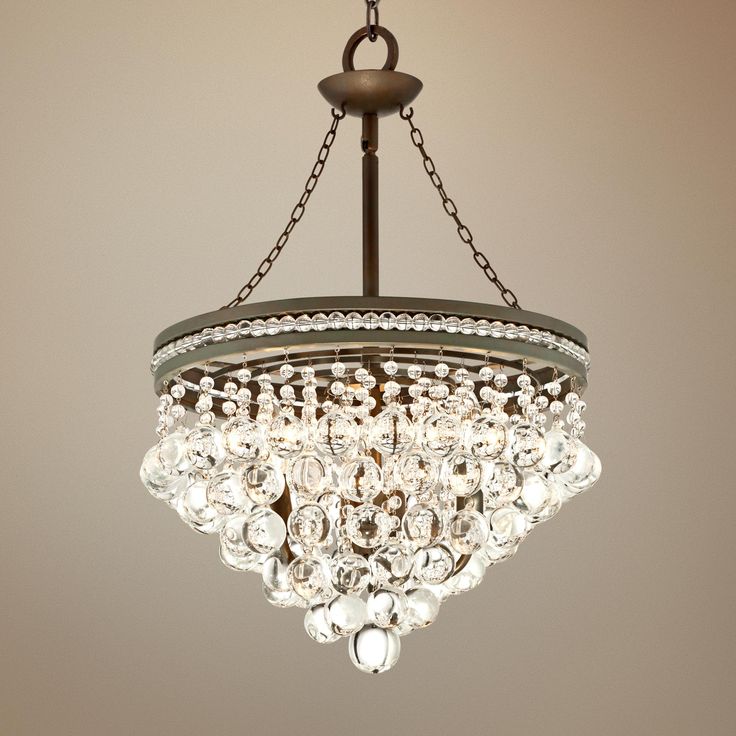 Well, that’s a little hard to do when my ceiling is eight feet high. In fact, that would be virtually impossible to do in any bathroom with a ceiling less than 12 feet high. I mean, with 11-foot ceilings, you could get away with some kind of large flush-mount or maybe even a semi-flush mount. But finding statement light fixtures that don’t hang any lower than 12 inches from the ceiling is virtually impossible.
Well, that’s a little hard to do when my ceiling is eight feet high. In fact, that would be virtually impossible to do in any bathroom with a ceiling less than 12 feet high. I mean, with 11-foot ceilings, you could get away with some kind of large flush-mount or maybe even a semi-flush mount. But finding statement light fixtures that don’t hang any lower than 12 inches from the ceiling is virtually impossible.
So that means that close to 100% of the chandeliers you see installed above bathtubs in America are a violation of national building code. And yet, we see them all over the place, including very nice shelter magazines, Parade of Homes, HGTV, builders’ websites, and all over Pinterest, Houzz, and Instagram.
Why do you think this is? Seeing that this is being done just as much by builders and designers as it is by regular homeowners and bloggers, ignorance is certainly not an excuse. Builders and designers know (or should know) the building code, and yet so many of them choose to ignore this particular one.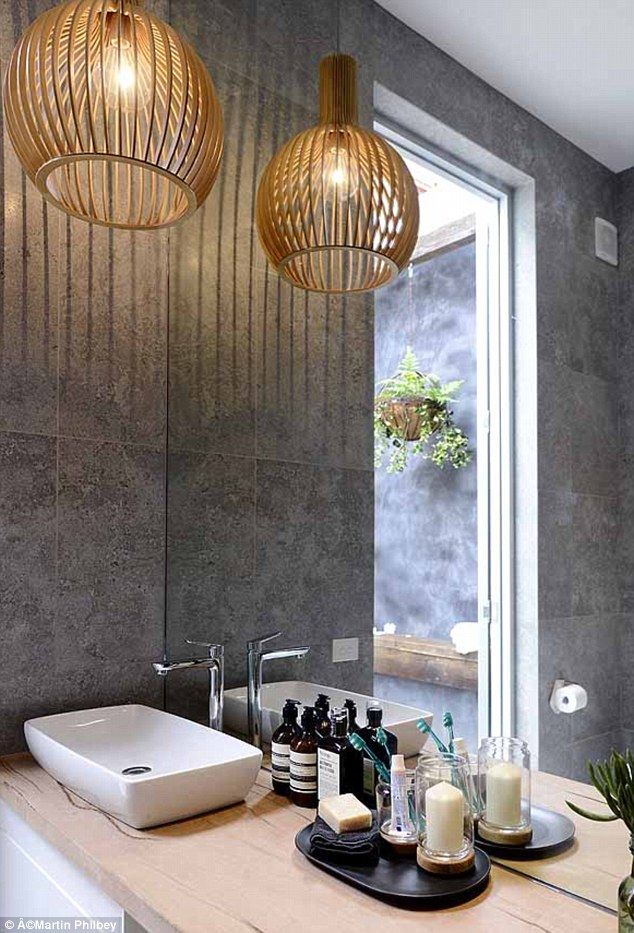
Which brings me back to my bathroom. I desperately want to join these thousands of people, including builders and designers, who ignore that building code. I want that bubble chandelier above my bathtub, hanging from my 8-foot ceiling. I can see it in my mind, and I think it would be stunning. And since I don’t climb on the sides of a tub, and my reach is only 76 inches, I can’t see how that chandelier could ever be a danger to me hanging above the bathtub — a bathtub that will never be used by anyone but me.
Because if I go the responsible way, and get a statement light to be hung in the center of the room where people will be walking through the room, that severely limits my options. Like I said above, finding a statement ceiling fixture that can be used on an 8-foot ceiling and leave enough clearance below for walking is incredibly challenging. But I did find a couple that I like.
This first one is a light that I’ve loved for years. And if I’m ever going to use this light anywhere, this bathroom would be my last chance to use it because our future master bedroom and family room will both have ceiling fans (a necessity in Texas), and I already have lighting I love in all the other rooms.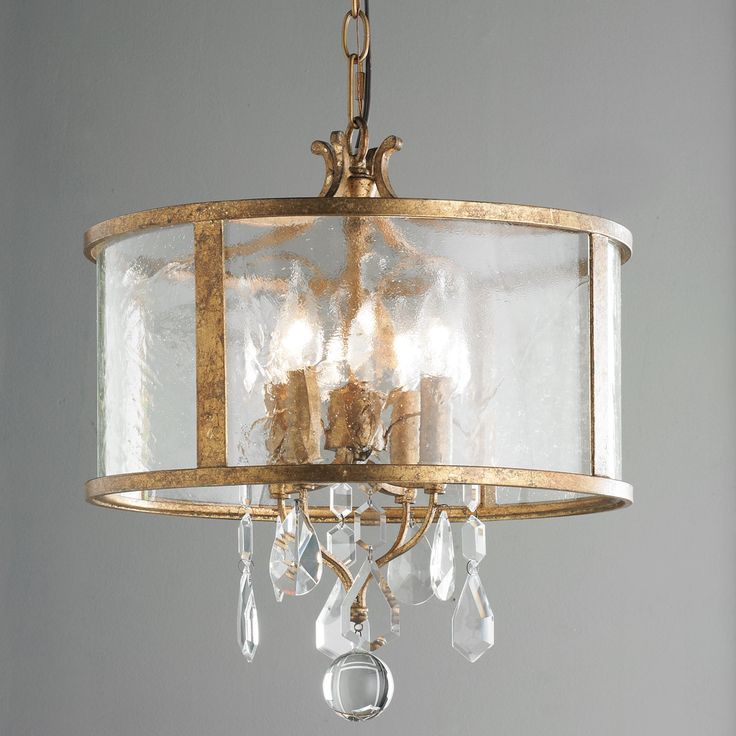
And the second one is kinda sorta like the bubble chandelier in that it gives that same bubble/cloud look.
Vega brushed brass flush mount light from CB2So here I stand at these crossroads. Do I follow the path of the other designers, builders, bloggers, homeowners, magazine publishers, etc., who ignore this building code, and in doing so, get exactly what I want in a room we’ve been waiting years for and that we’re paying tens of thousands of dollars for? Or do I have to be the adult in the room who says, “That’s against building code. I’m going to find other options that meet the building code.”
What would you do? If you were paying about $30,000 for a top-to-bottom custom bathroom, and your vision included a chandelier above the tub, what would you do?
And if you were a blogger who shares pictures of her home online, potentially seen by hundreds of thousands of people, would your decision be different?
Kristi Linauer
Addicted 2 Decorating is where I share my DIY and decorating journey as I remodel and decorate the 1948 fixer upper that my husband, Matt, and I bought in 2013.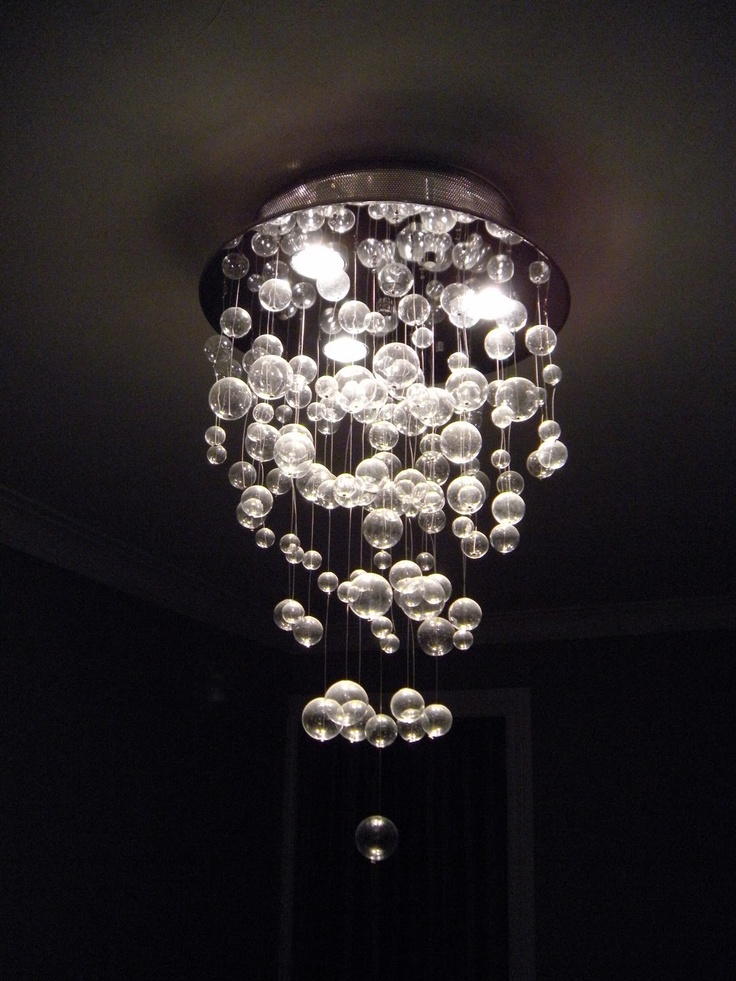 Matt has M.S. and is unable to do physical work, so I do the majority of the work on the house by myself. You can learn more about me here.
Matt has M.S. and is unable to do physical work, so I do the majority of the work on the house by myself. You can learn more about me here.
I hope you’ll join me on my DIY and decorating journey! If you want to follow my projects and progress, you can subscribe below and have each new post delivered to your email inbox. That way you’ll never miss a thing!
Chandeliers in the bathroom, or what kind of lamps are needed for wet rooms
The question "is it possible to hang a chandelier in the bathroom?" occurs more frequently in the last five years. Some have heard that there is a taboo on the chandelier in the bath. That it has something to do with security and the mysterious "IP". But on reflection, as a rule, everything ends, and desires remain unfulfilled.
Let's look at the features of lighting in wet rooms and bathrooms in more detail, and clarify for ourselves what to do and how to do it.
What kind of lighting is in the bathroom?
The bathroom is a room with a high level of humidity due to the presence of a shower (shower) and / or a bath bowl, a sink area.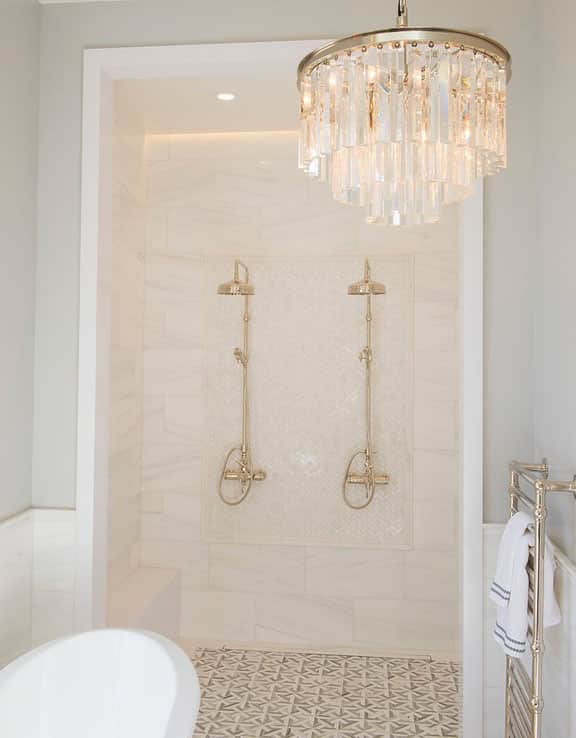 First of all, the bathroom is a room with several zones of humidity.
First of all, the bathroom is a room with several zones of humidity.
See list of wet zones below:
- Zone 1 - bath (or shower) - water and steam container. This is a difficult and unnecessary area for placing fixtures. Lamps with a degree of protection 9 are installed in the water.0013 IP68 . This is the maximum possible degree of dust and moisture protection. Products with this marking are hermetic, and they are immersed under water.
As a rule, lamps are not built into the bath itself, and standard lighting from the manufacturer of the cabins is provided in shower cabins. But if the task is to install floodlights in a pool or fountain, then choose equipment with IP68 .
- Zone 2 - space surrounding the bathtub : walls around the bowl and ceiling. It is recommended to install lighting equipment with a degree of protection of IP65 (protected against water jets, waterproof).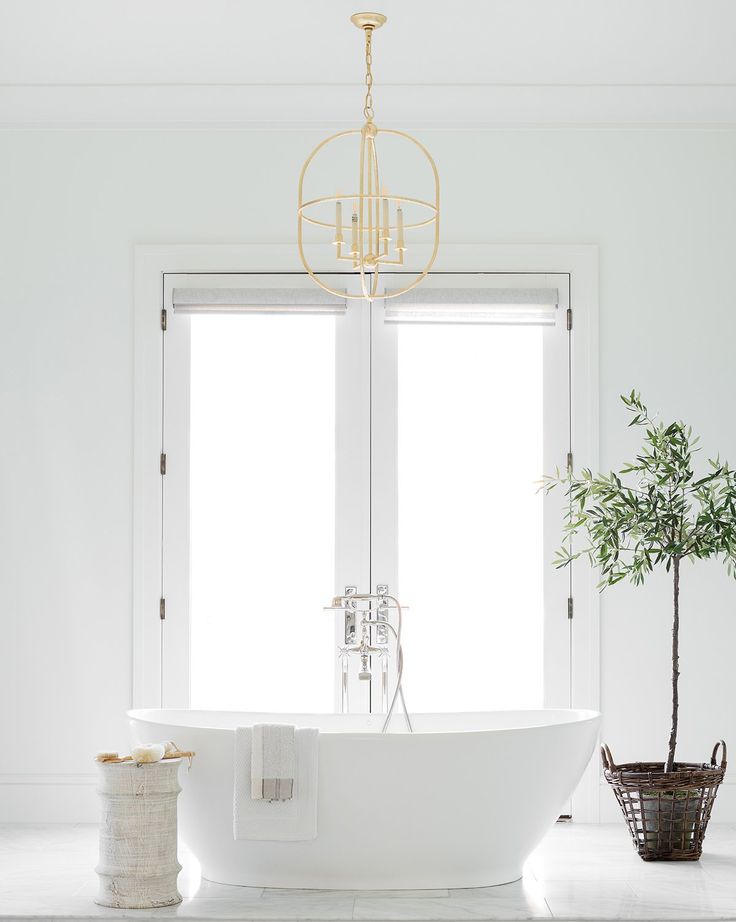 Moisture and water falling on the lamp does not affect the correct operation of the lamps.
Moisture and water falling on the lamp does not affect the correct operation of the lamps.
These lamps are usually made in the form of simple circles or squares. They are built into a false ceiling or mounted on a surface. The task of these lamps is to work reliably in a humid area.
- Zone 3 - Near zone around the bath, up to 60 cm away from it. Luminaires with protection 9 are installed here0013 IP44 (drip and splash proof). So you can splash in the water, whip up fragrant foam or sing in the shower without fear.
- Zone 4 - the remaining space, remote from the source of moisture and water jets. This zone in terms of dust and moisture protection is the same as a room, kitchen or corridor. Here you can afford any lamps, including those with IP20 (without moisture protection).
How to light the bathroom?
The correct answer to this question greatly depends on the size of the room, its design features and the design objectives.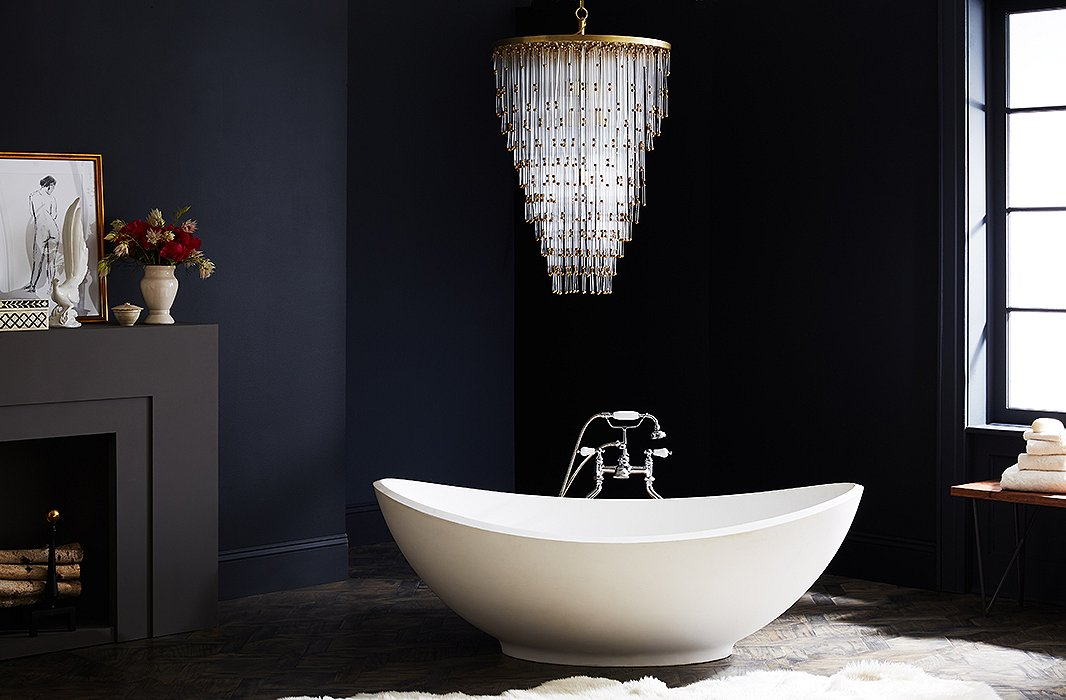
Some bathrooms have windows. This is a positive point, since a person receives the maximum amount of natural light through the window, and you can turn on the lamps only at night. Light finishes, furniture, plumbing make such a space visually larger and lighter.
There are lovers of dark interiors. They like to be surrounded by almost black stone or concrete walls, where the lighting is realized by accents on key elements (sink, bathtub bowl, wall niche). But if you are one of those romantics who like to read a book or a magazine in the bath, then you cannot do without even general lighting (on average, illumination is 150–200 lux).
For fans of non-standard solutions, it is possible to organize lighting using LED strips, which indicate only the contours of architectural elements. Visually, it seems as if objects are floating in the air. And to create a romantic or meditative mood, decide on light dynamics, install RGB LED lights and ribbons.
What to remember when organizing bathroom lighting?
Taking into account the plan of wet areas, posted at the beginning of this article, it is possible and necessary to make a bathtub a pleasant and comfortable place to be in.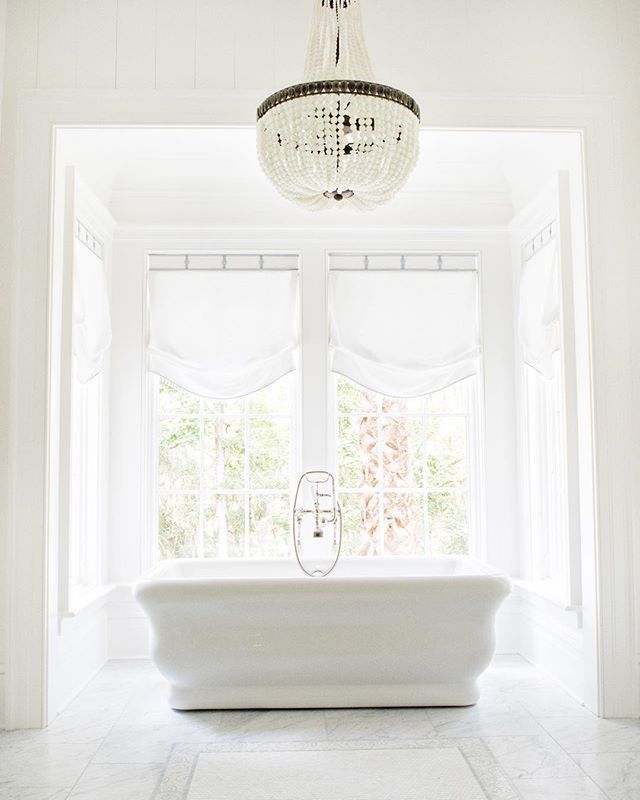 It all depends on individual wishes.
It all depends on individual wishes.
Recommendations:
- Provide ventilation and/or ventilation;
- In humid and wet areas, install luminaires with a suitable IP rating. Let the moisture protection be higher than recommended in some areas, but you will be calm and safe;
- Consider the needs and desires of your occupants when designing bathroom lighting. Each person is individual and his personal opinion may not coincide with the traditional approach.
Which luminaires should be used to illuminate the bathroom?
Conventionally, bathroom lighting can be divided into three functional areas: the area above the bath and next to it, the mirror area, storage / laundry / free space.
1 - for area above the bath , where steam and water jets, install waterproof fixtures ( IP65) . By placing them in a uniform grid on the ceiling, you organize general lighting. As an original solution, create a "starry sky". You will look at the shining romantic stars, lying in the foam.
You will look at the shining romantic stars, lying in the foam.
2 — the area of mirror is illuminated so that a person looking into it sees his or her evenly illuminated face. In such cases, side sconces with frosted glass are placed on both sides of the mirror. The light in this area is especially important when styling and applying makeup. The contour lighting of the mirror plays a decorative role. By illuminating yourself and the wall on which the mirror is located, it is impossible to illuminate a person's face. This technique is used in public places, attracting the attention of visitors. For a successful “selfie”, you will have to turn on the additional flash of the phone so that the model’s face becomes recognizable against a dark background. To create a planned decorative effect in private interiors, illuminated mirrors are used in addition to the main lighting.
Additionally, the sink/mirror area is decorated with hanging lamps.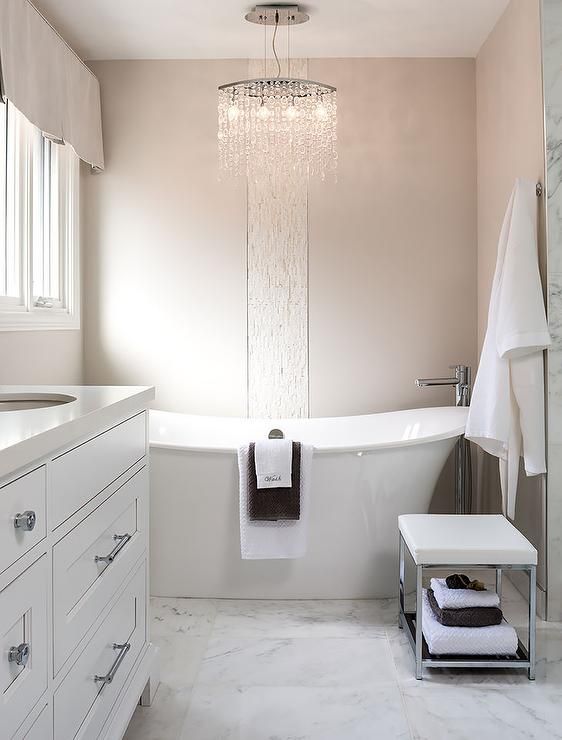 Remember that if the ceiling does not transmit light, then the light spot will be on the surface of the countertop into which it shines. For functional lighting, the plafond must transmit light from the source in all directions (diffuse light) and not give glare to the eyes.
Remember that if the ceiling does not transmit light, then the light spot will be on the surface of the countertop into which it shines. For functional lighting, the plafond must transmit light from the source in all directions (diffuse light) and not give glare to the eyes.
3 - for general lighting of the space , creating a special atmosphere and implementing the design solution of the room (taking into account that the area and ceiling height allow) you can safely hang a chandelier in the bathroom. If it hangs at a safe distance from water, ventilation is working in the room, please yourself with the desired lamp in the bathroom.
There are rare specimens - classical style chandeliers with a degree of protection IP65 . They can be safely placed in the bathroom, pool, hammam and even on the street.
Chandeliers in the bathroom
We conclude that if a luminaire ( IP20 ) not protected from moisture is placed in a place that is safe from water jets and steam concentration, then chandeliers in the bathroom can be hung.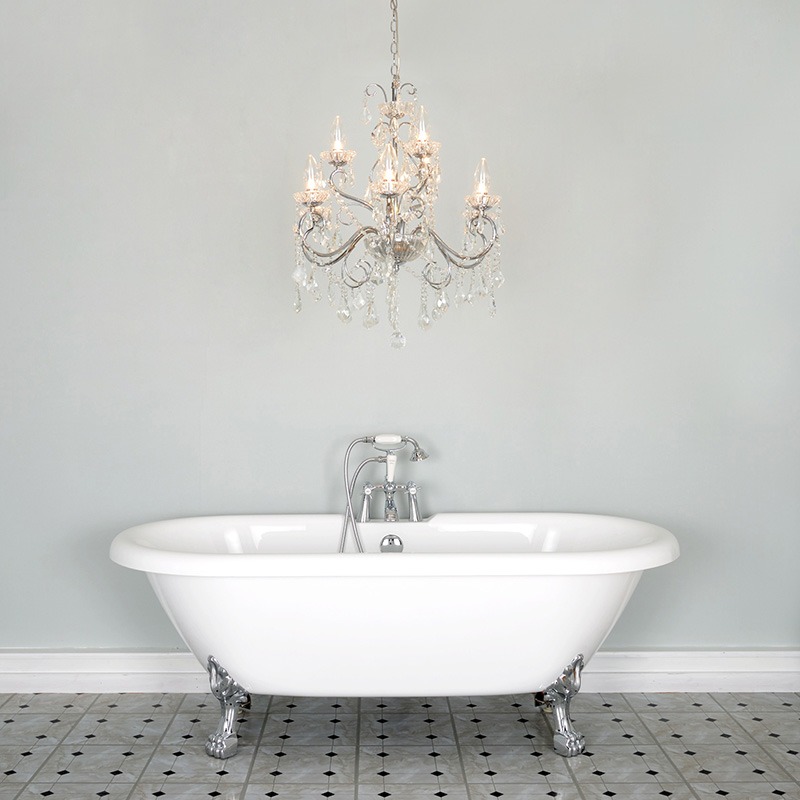
Let the crystal pendants play like sunbeams on the wall tiles, the original metal frame shapes inspire creative ideas. Let designer sconces and pendant lamps become a spectacular addition to the interior, an expression of individuality.
Which lamps to use in the bathroom
Technical requirements for lighting fixtures
A bathroom is a place in an apartment or house where the operating conditions of lamps are close to extreme. Frequent changes in air temperature, high humidity, splashes of water - not all interior lighting devices can withstand such a “microclimate”.
For this reason, the main parameter for choosing a luminaire for a bathroom is the degree of its protection from adverse environmental conditions. The degree of dust and moisture protection can be found by examining the information on the device case.
The required marking begins with the letters IP, followed by two numbers, the first of which indicates the level of protection against dust, the second - protection against moisture.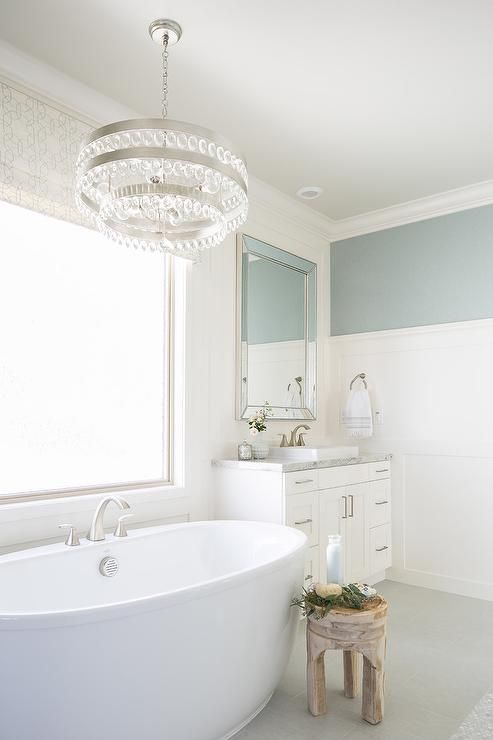 The higher the numerical value of the index, the more reliable the lamp. The minimum level of moisture protection of the lighting device for rooms with high humidity is IP44, the maximum is IP67.
The higher the numerical value of the index, the more reliable the lamp. The minimum level of moisture protection of the lighting device for rooms with high humidity is IP44, the maximum is IP67.
The choice of light source will also depend on the area of the bathroom in which it will be located. There are three of them:
- Zone 1 - directly above the bowl and washbasin or inside the shower cabin. Here it is allowed to place low-voltage lighting devices with a degree of protection of at least IP67, since there is a high risk of contact of the lamps with water up to their complete immersion. Less protected devices are simply not safe to operate in this area.
- Zone 2 - 30-60 cm from the borders of the first zone. It is allowed to place the same low-voltage devices here, but with a lower degree of protection - from IP 45 to IP 67. It is important that the light sources are sufficiently reliable, since the likelihood of water splashing on them in this area still remains.
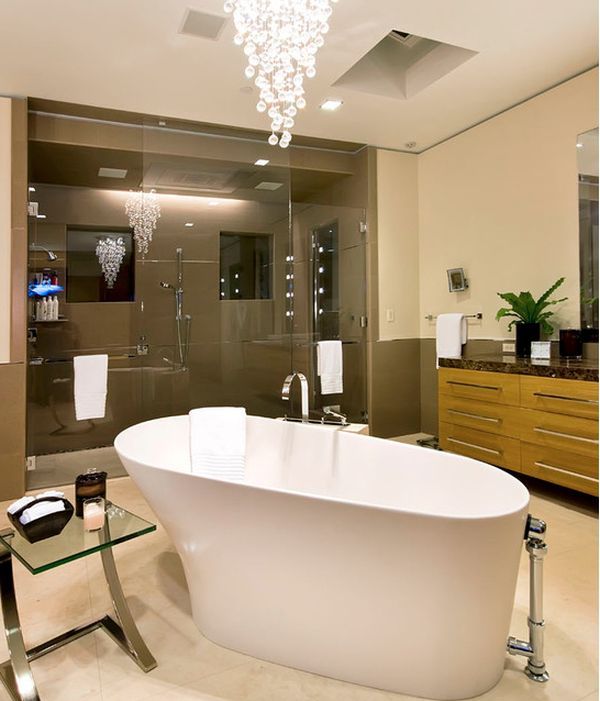
- Zone 3 - 60 cm from the borders of the second zone. Here, water jets no longer threaten lighting fixtures, but since the humidity of the air, as in the rest of the room, is high, it is better to select light sources with an IP44 protection index or slightly lower.
Please note: if there is not enough good ventilation in the bathroom and even on distant walls condensation forms periodically, then there are no relatively safe zones in the room, so the lamps for it are selected only for zone 1 and zone 2.
Types of lighting for the bathroom rooms
Artificial lighting that can be used in the bathroom is divided into three types: ceiling, wall and floor. In one room, several variants of light sources can be combined at once, thus achieving an ideal luminous flux both from a decorative and functional point of view.
Ceiling light
This type of lighting is the main one. It is selected based on the dimensions and design features of the room, taking into account the presence / absence of additional light sources.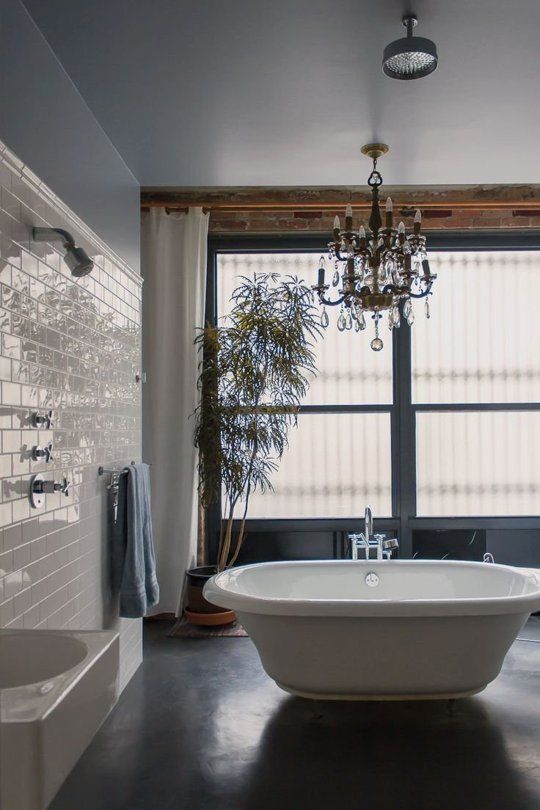
Traditional chandeliers are not suitable for standard bathrooms, they look too bulky in them, and simply interfere with hygiene procedures. An excellent alternative to such devices can be overhead or recessed ceiling lamps, LED strips, spot or spot lighting systems.
Wall lighting
Wall light sources are designed for zoning space and creating the highest quality lighting in individual work areas. If the area of the bathroom is small (less than 6 sq. M), there is no need for wall lighting - the main ceiling lamp will also cope with its functions. In more spacious rooms, you can use sconces, overhead appliances or spots.
Usually wall lamps are placed near the mirror. In this case, sconces should be used in pairs - on both sides of the reflective surface. Overhead devices are universal, they can be located horizontally above and below the mirror, or vertically - on the sides of it.
Spot systems can also be placed at the top, bottom or side, there is only one recommendation - the ceiling lamps of such devices should not be reflected in the mirror and other glossy surfaces - with such an arrangement, light sources will "dazzle" the eyes.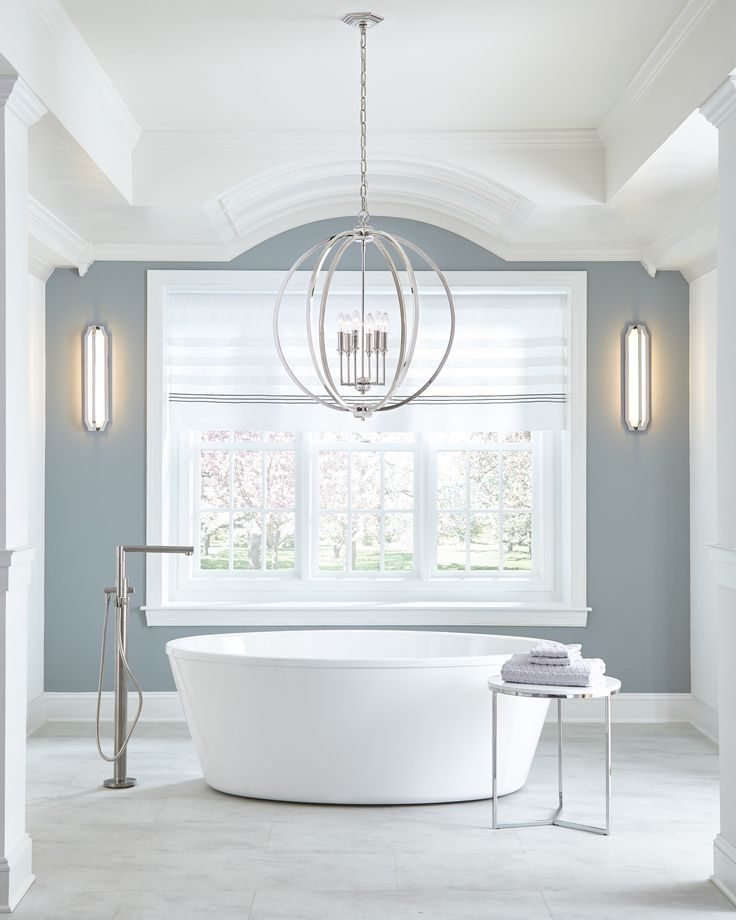
The mirror should not be illuminated with devices with bright colored shades - from such light sources your reflection will be distorted: the complexion and hair will become unnatural. The best option - devices made of frosted or transparent glass.
Floor lighting
This lighting fixture has a decorative function: it allows you to create a special cozy and romantic atmosphere in the bathroom. To organize such lighting, LED strips, recessed spotlights, luminous tiles, etc. are used.
LED strips are usually “laid” along the contours of the bathtub, washbasin and other furniture. An alternative to them can be LEDs placed randomly on the cable and laid in the tile joints of the floor. This backlight resembles a starry sky and looks very unusual.
Spotlights are placed along the perimeter of the room or along plumbing fixtures and furniture. The disadvantage of this type of lighting is the complexity of installation and subsequent replacement of light bulbs in appliances.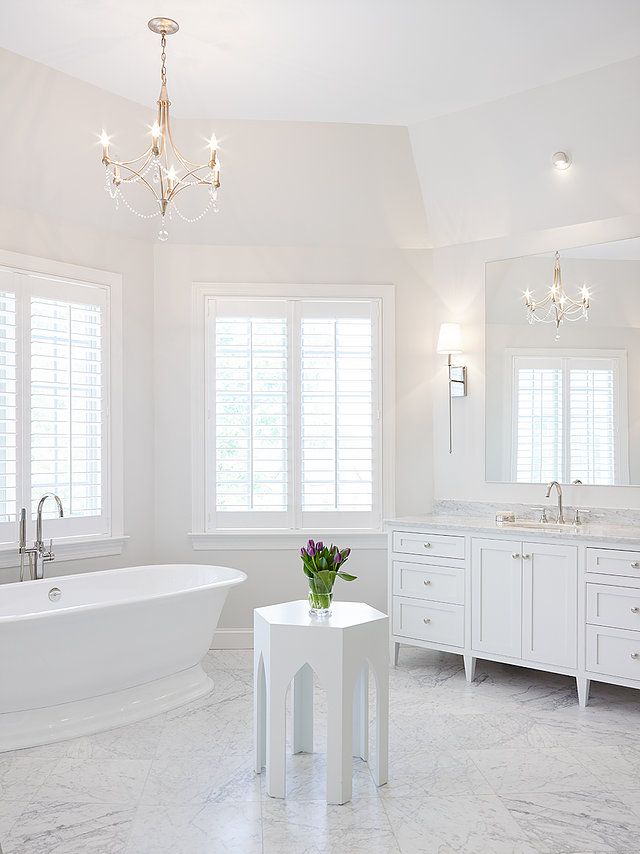
Luminescent floor materials glow on their own and are generally independent of the power supply. They have only one minus - the high cost. In addition, turning off such a lamp in the dark does not work.
Light characteristics
Types of lamps
Traditional incandescent lamps as well as fluorescent and LED light sources are suitable for bathrooms. Halogen bulbs are not safe to use in rooms with high humidity - if water gets on them, the glass can simply “explode” and injure the user.
Incandescent lamps tend to heat up during use and have a relatively short lifespan. Fluorescent light sources contain "mercury vapor", so their use in everyday life is, in principle, potentially dangerous.
The best option for a bathroom is LEDs: they give a good quality of light, do not heat up and last as long as possible.
Luminous flux power
According to established standards, for normal bathroom lighting, at least 200 Lux (lux (lx) - a unit of illumination) per 1 sq.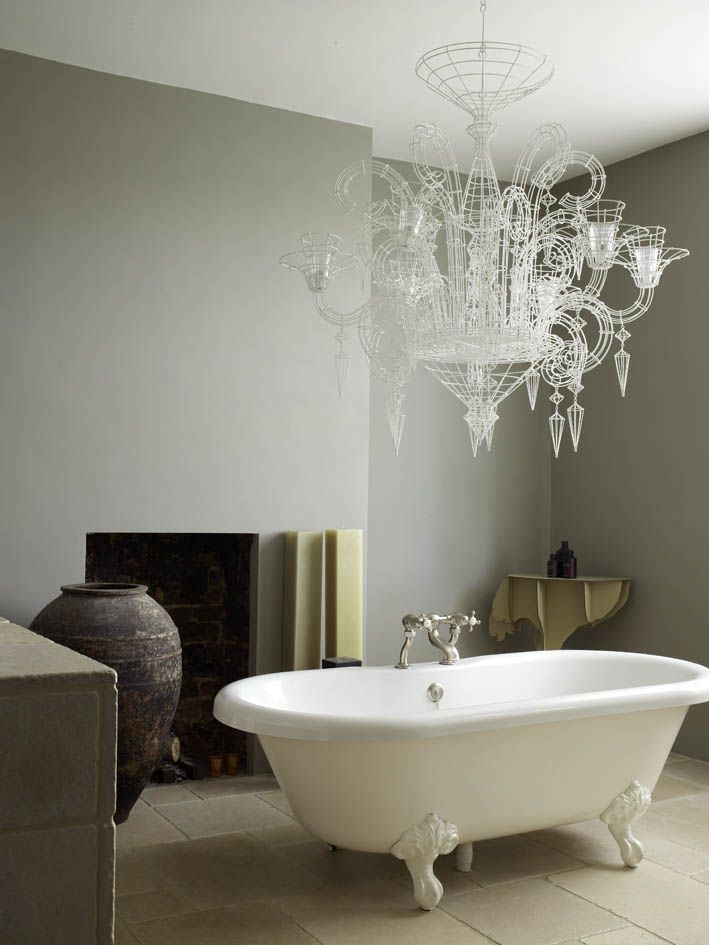 meter of the room. Light output of lamps is measured in lumens (lm). 1 lux equals 1 lumen per square meter. meter.
meter of the room. Light output of lamps is measured in lumens (lm). 1 lux equals 1 lumen per square meter. meter.
For a standard 6 sq. m requires lighting with a power of 1200 lx. This power of the luminous flux is created by 1 incandescent lamp with a power of 100 W or an LED lamp with a power of 11 W.
Color rendering and temperature of light
The color rendering of a light source is the quality of reproduction of the natural colors of objects by artificial light. Sunlight has the maximum color rendering - with it, the entire surrounding space looks the way it really is.
Incandescent lamps give light that is very close to natural, they practically do not distort the perception of objects. For LEDs, the indicator is slightly worse, but it is also within the acceptable norm.
The temperature of the light also affects the display of the surrounding reality. Light can be warm, neutral or cool. For the bathroom, it is better to select sources in the “warm” or neutral range; it will be uncomfortable to be in a cold room.